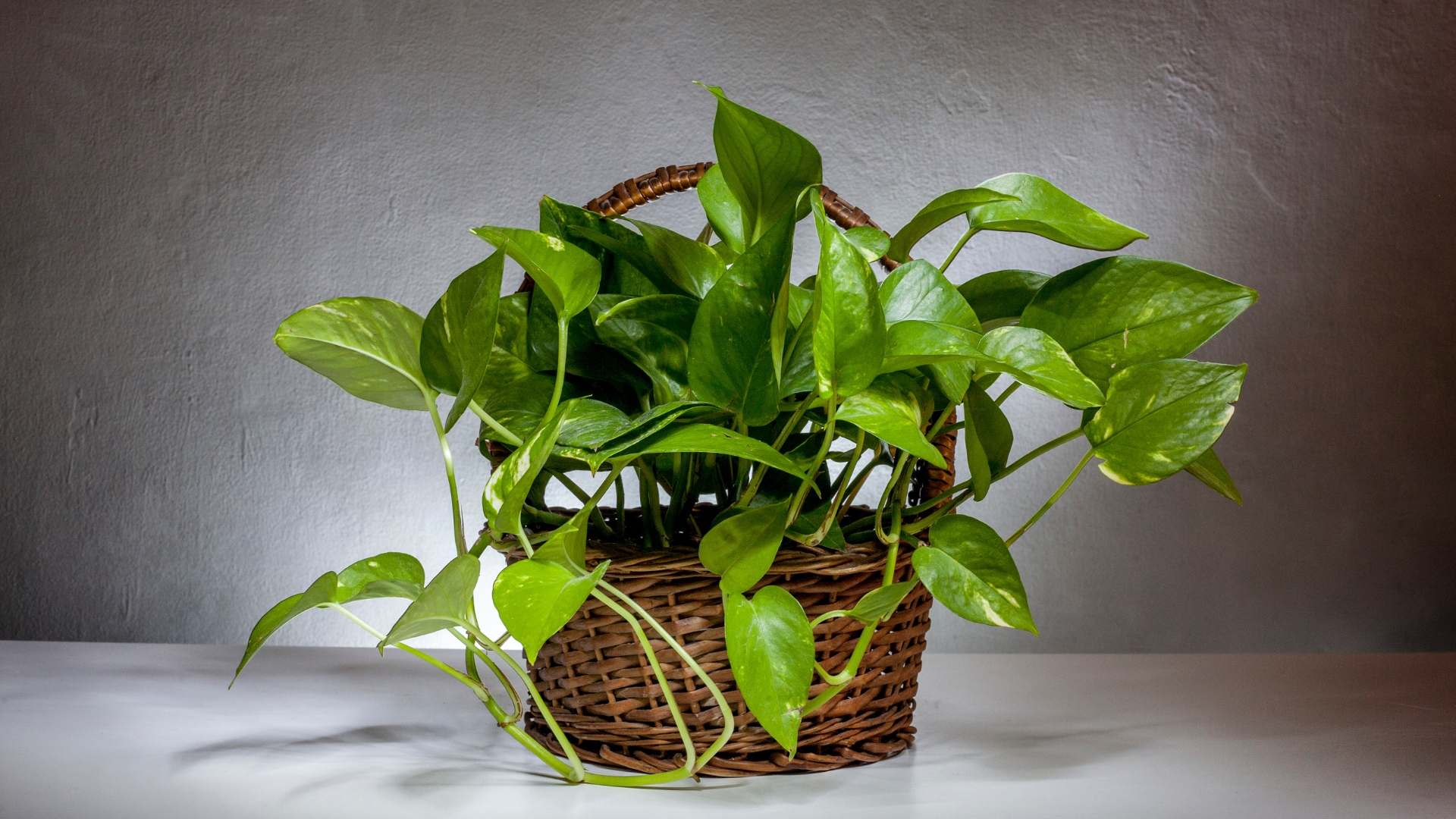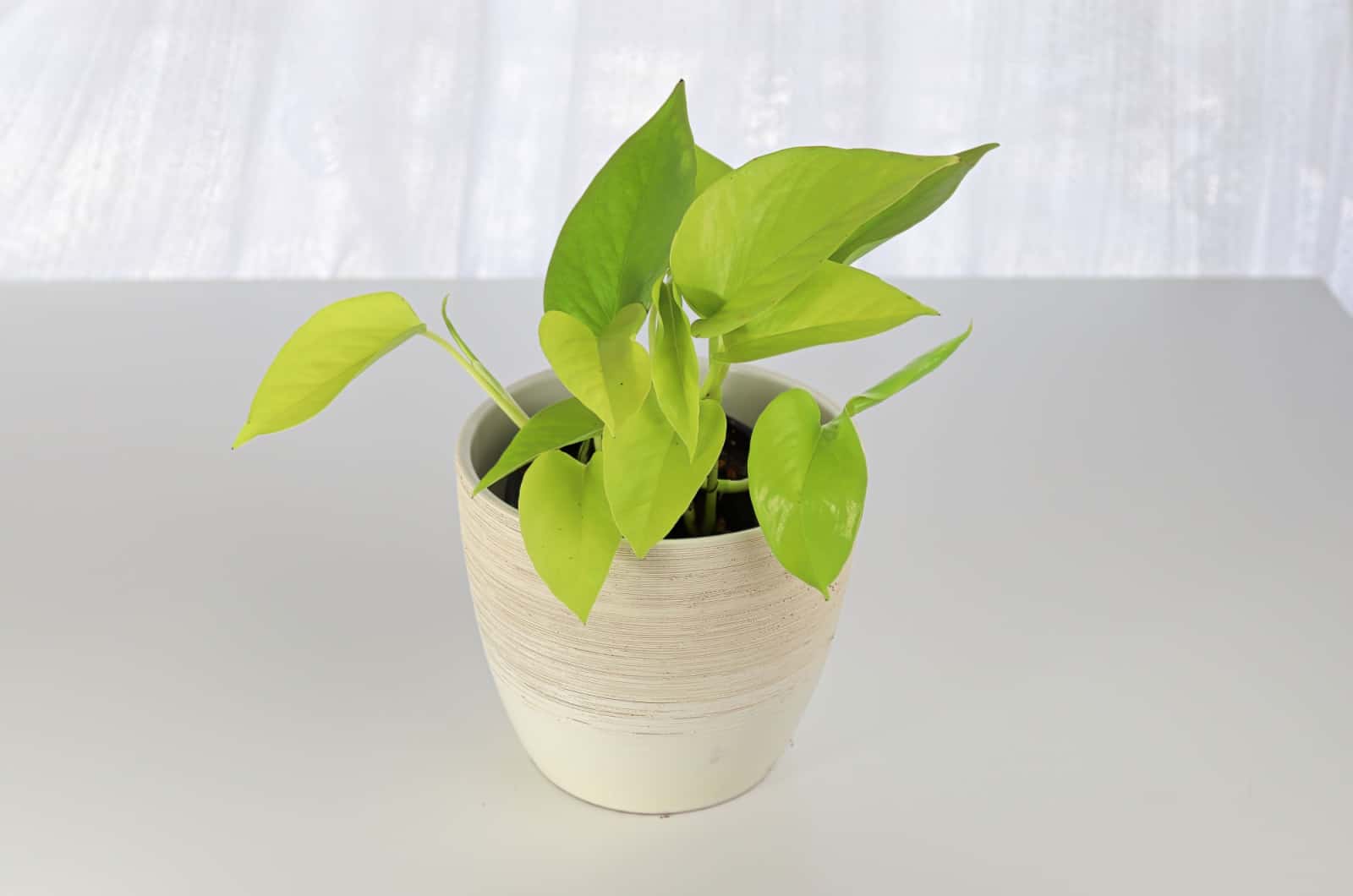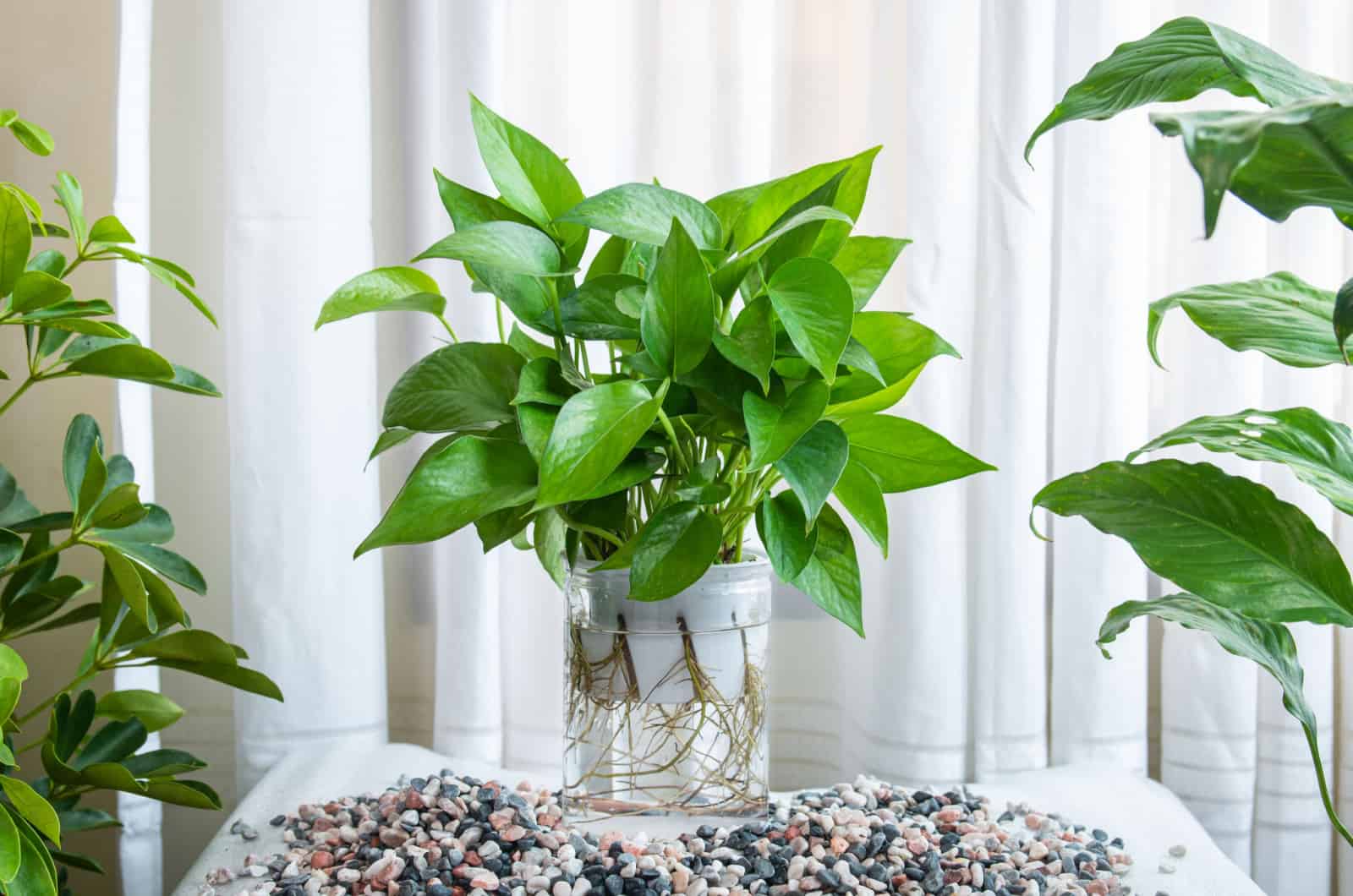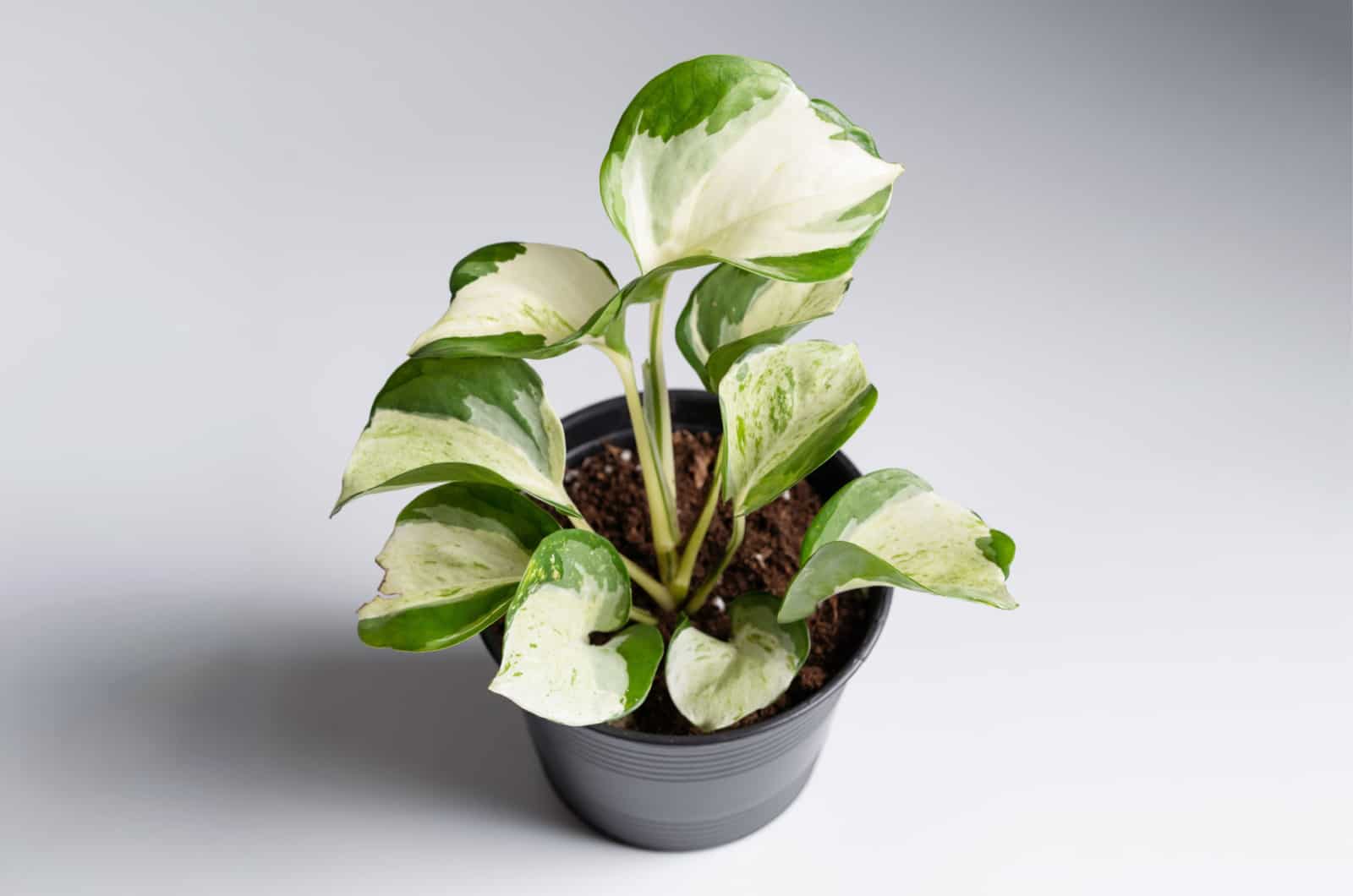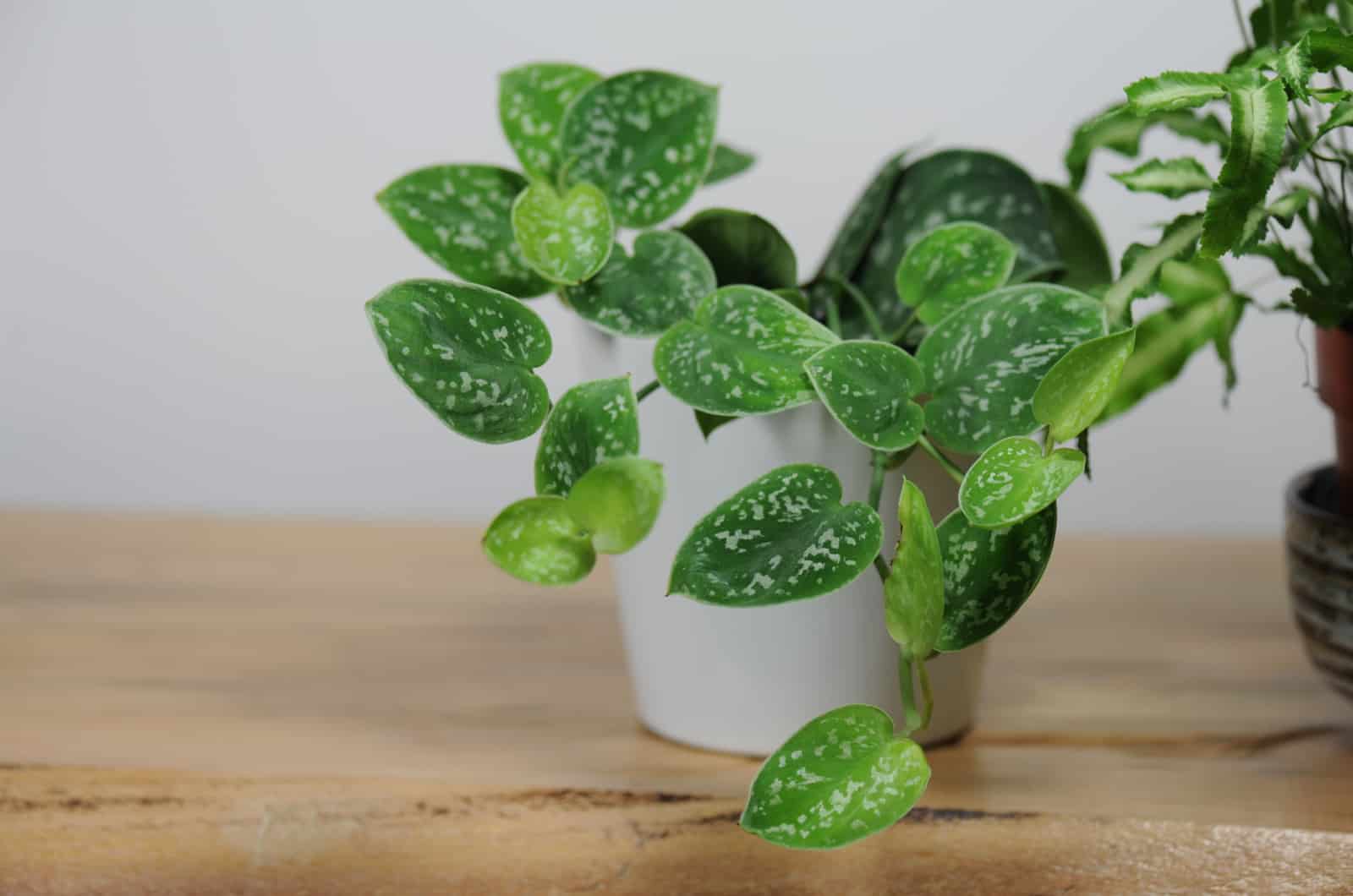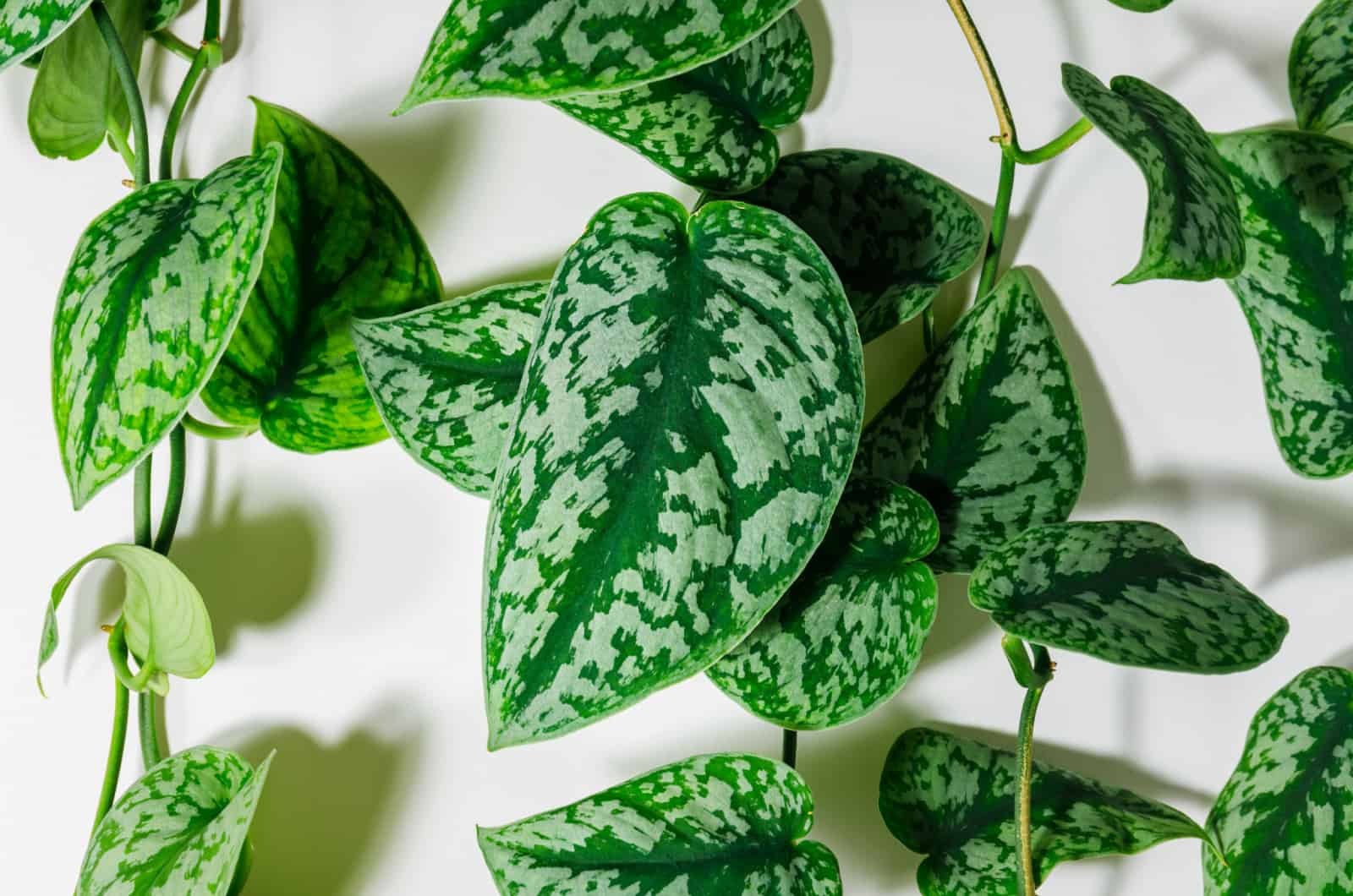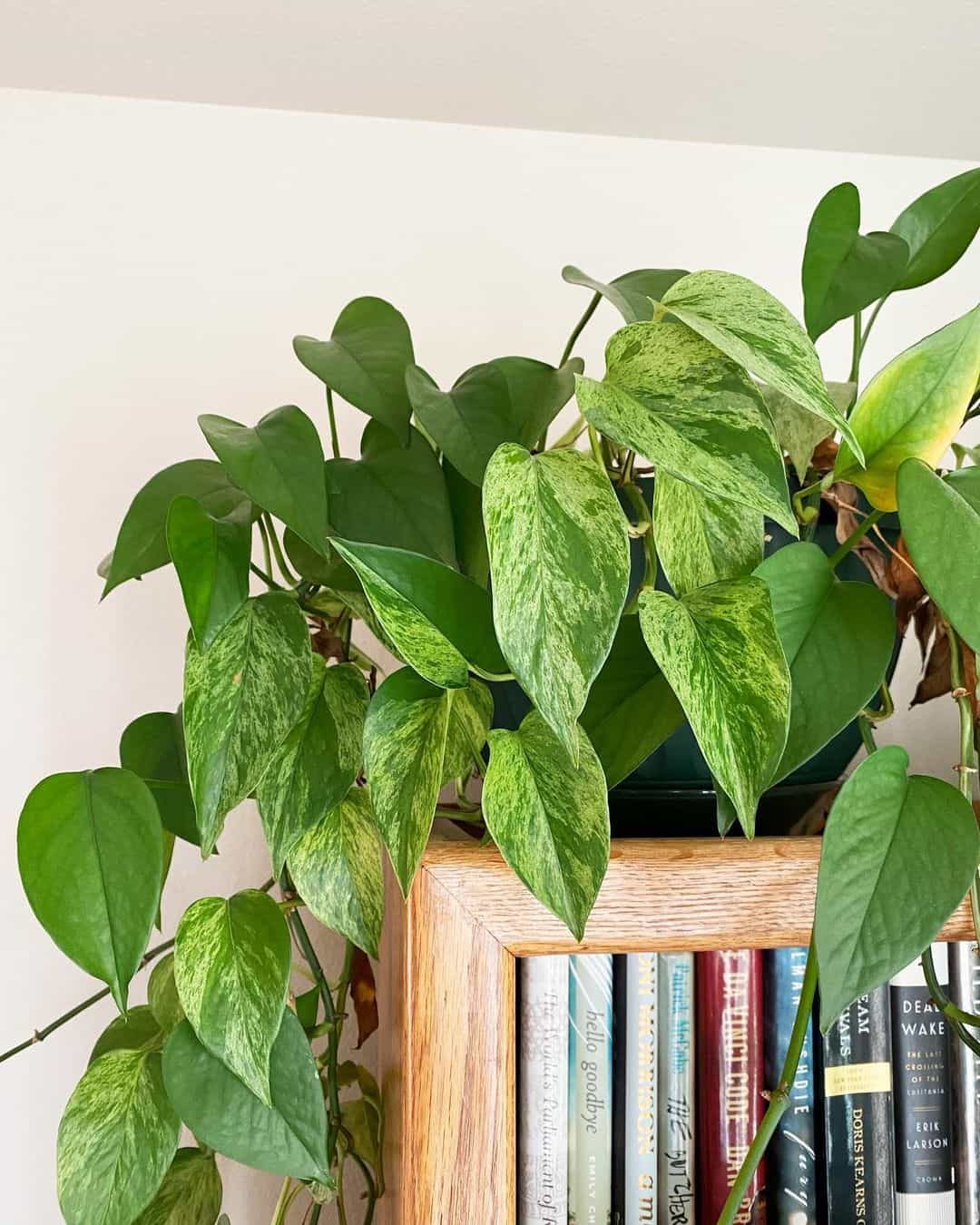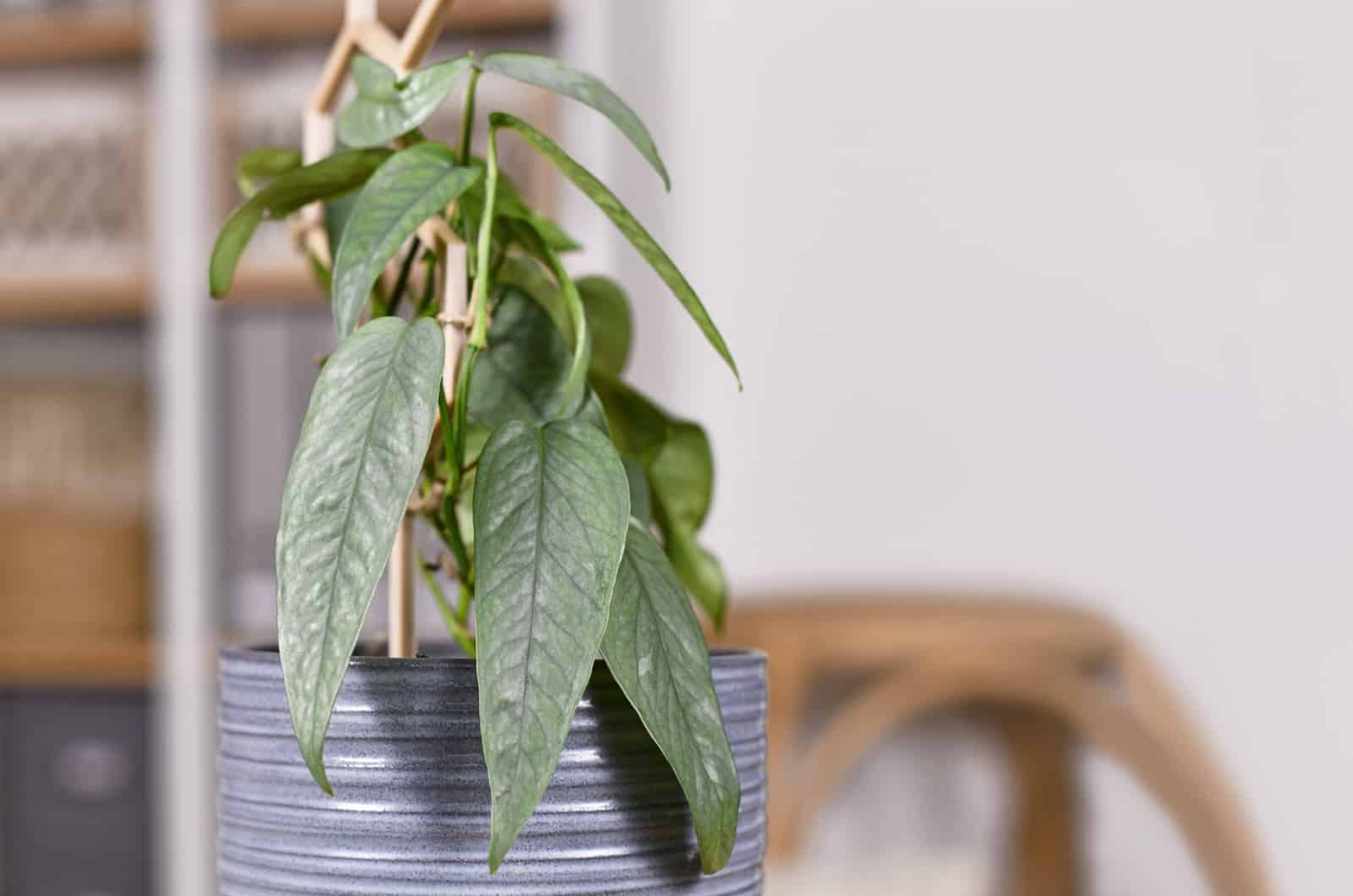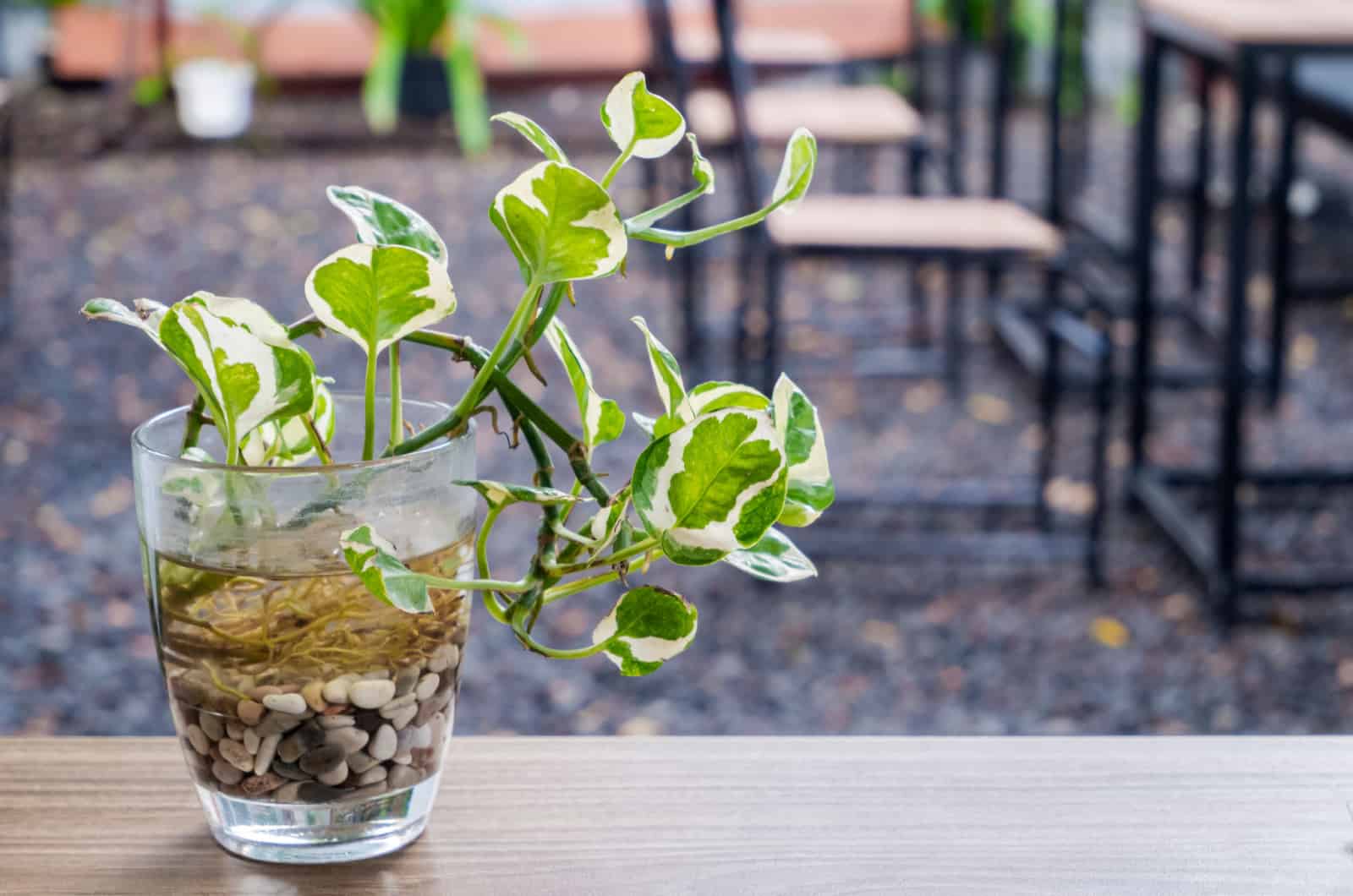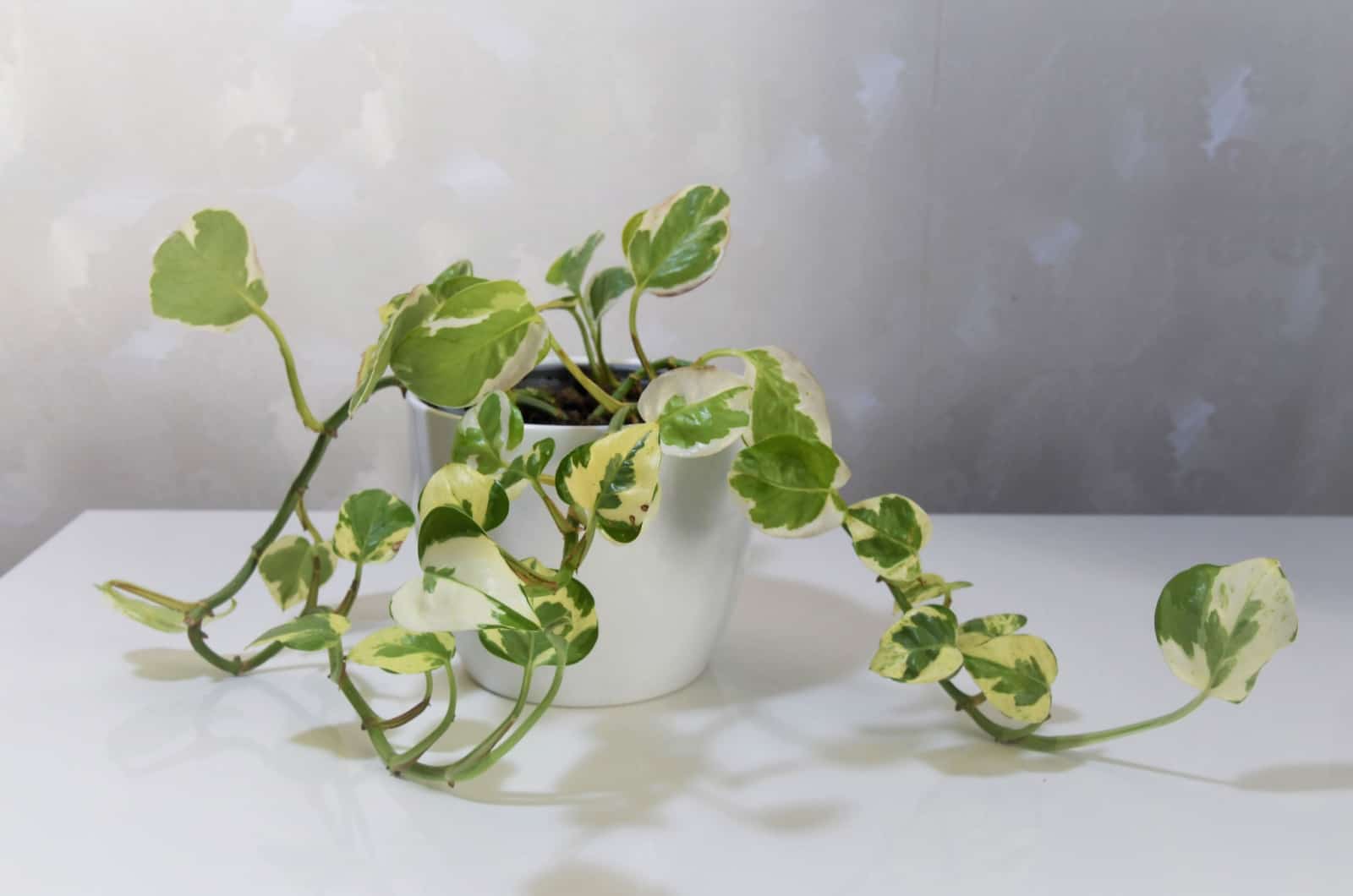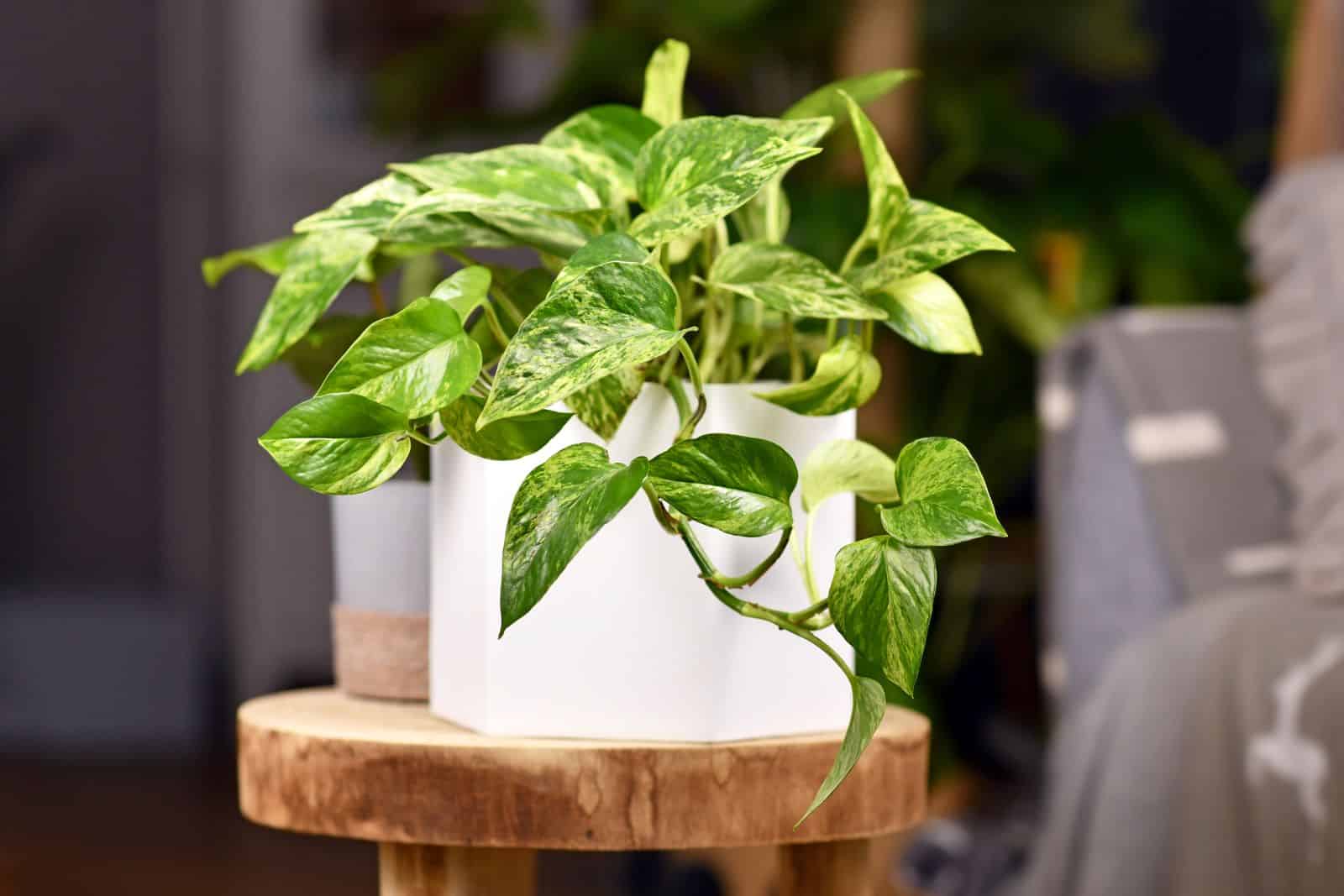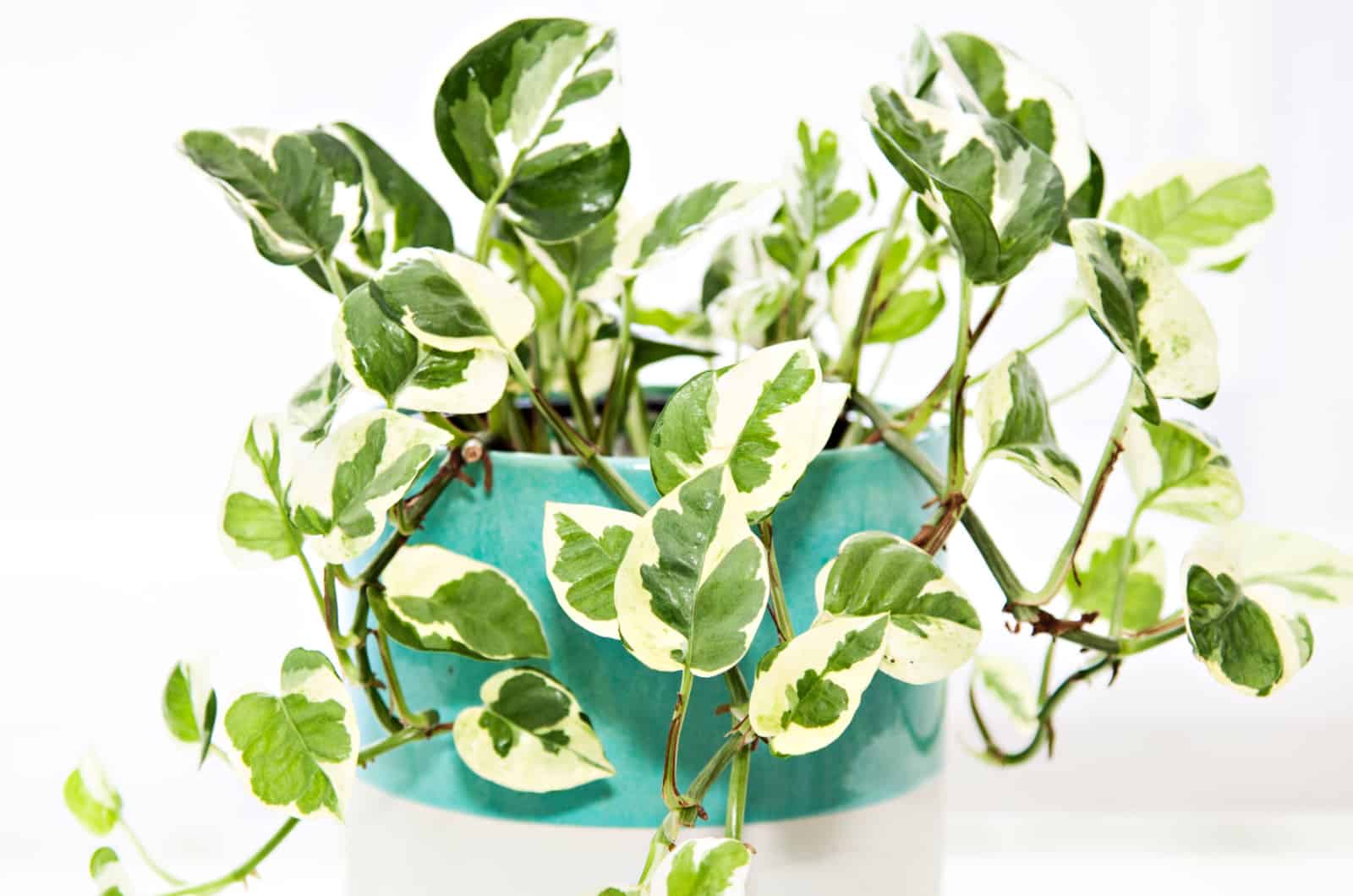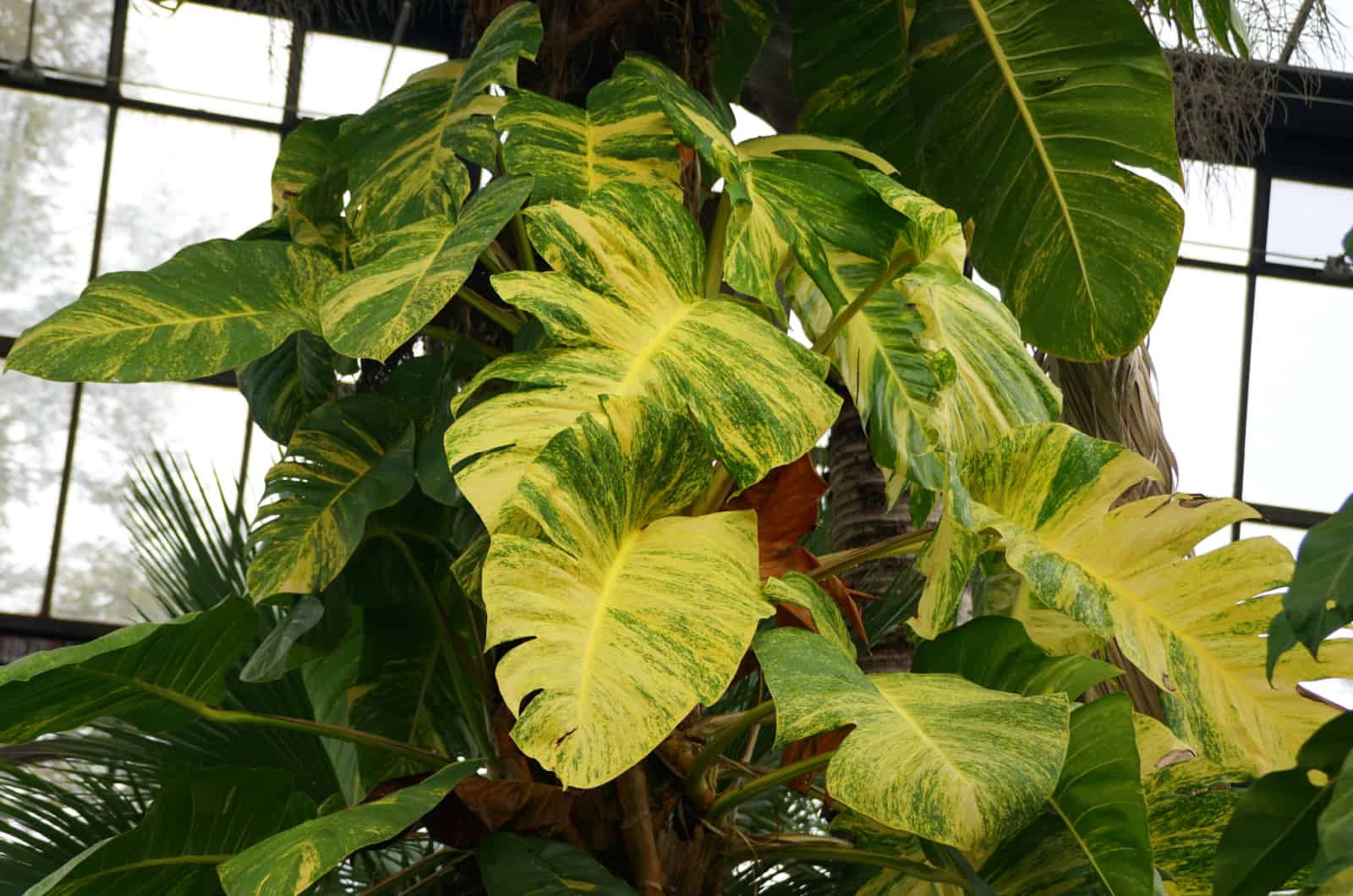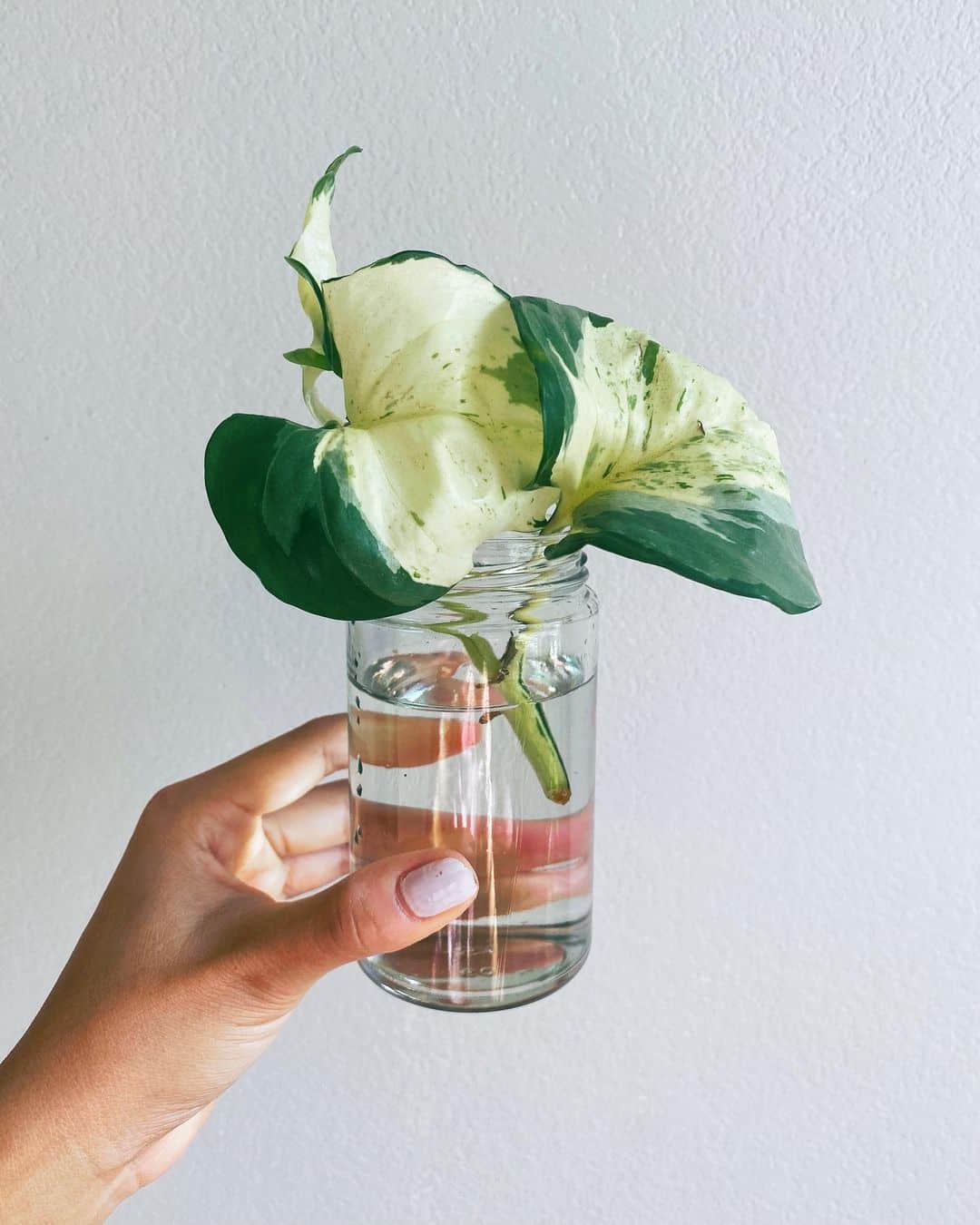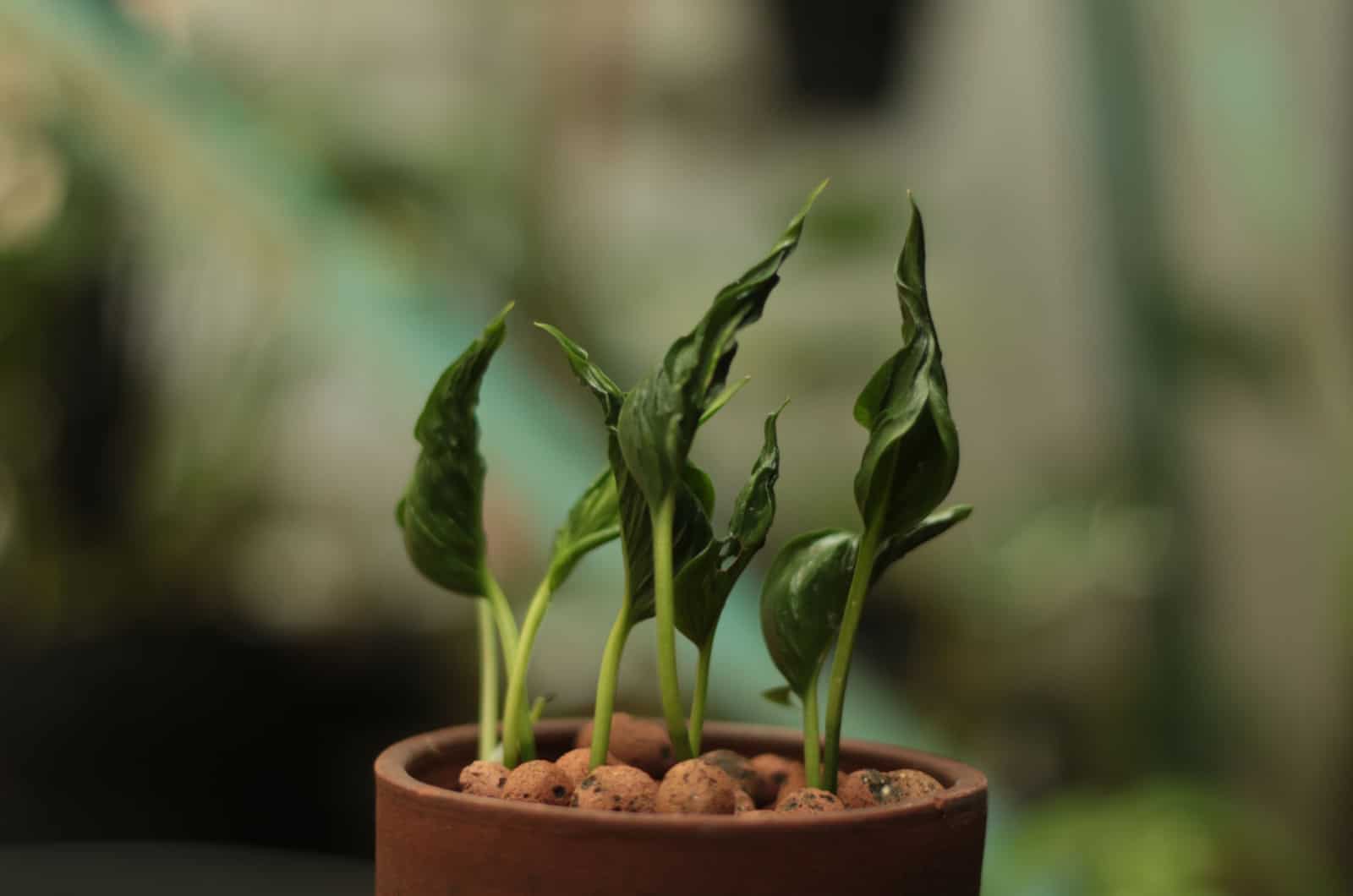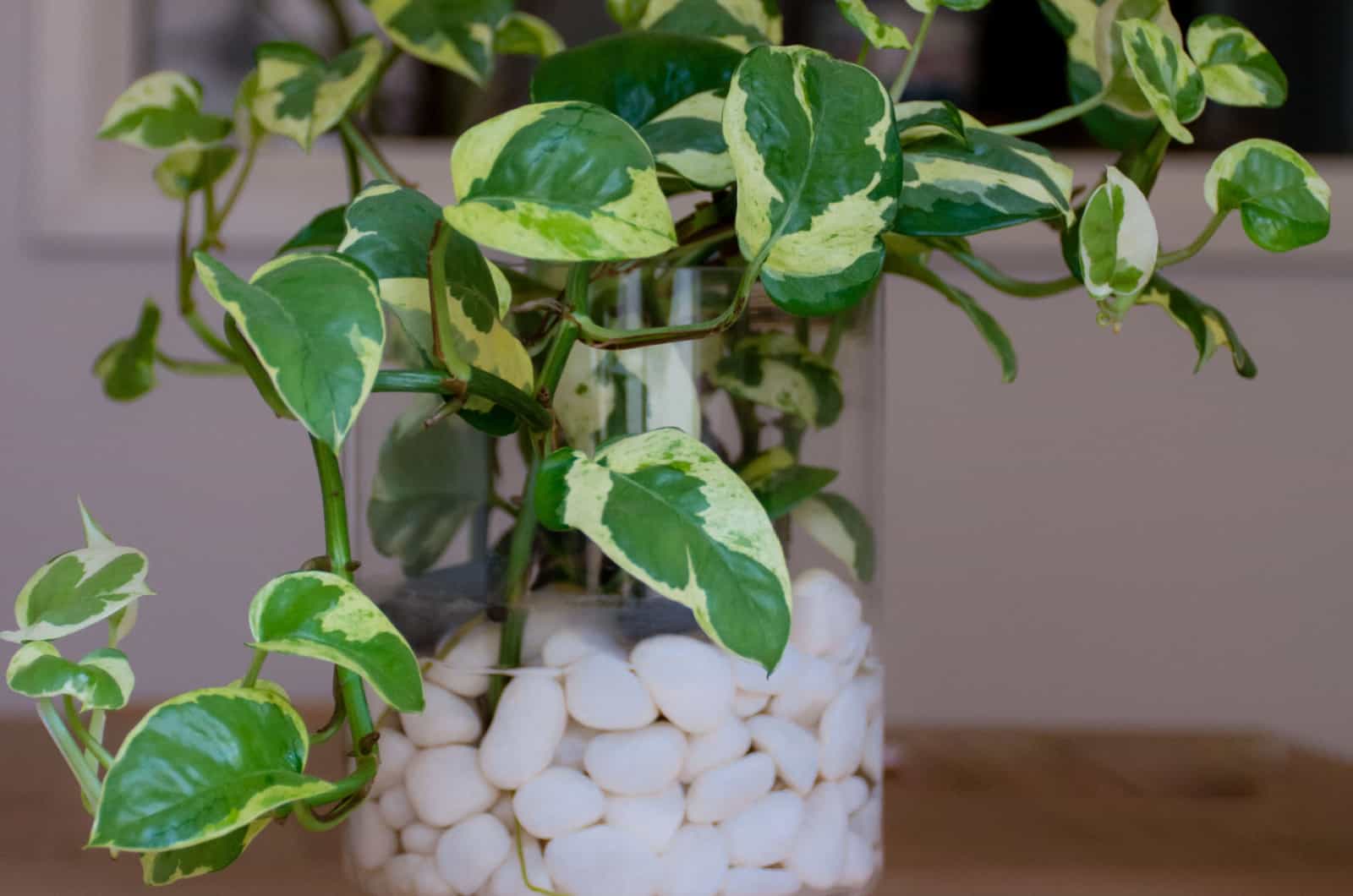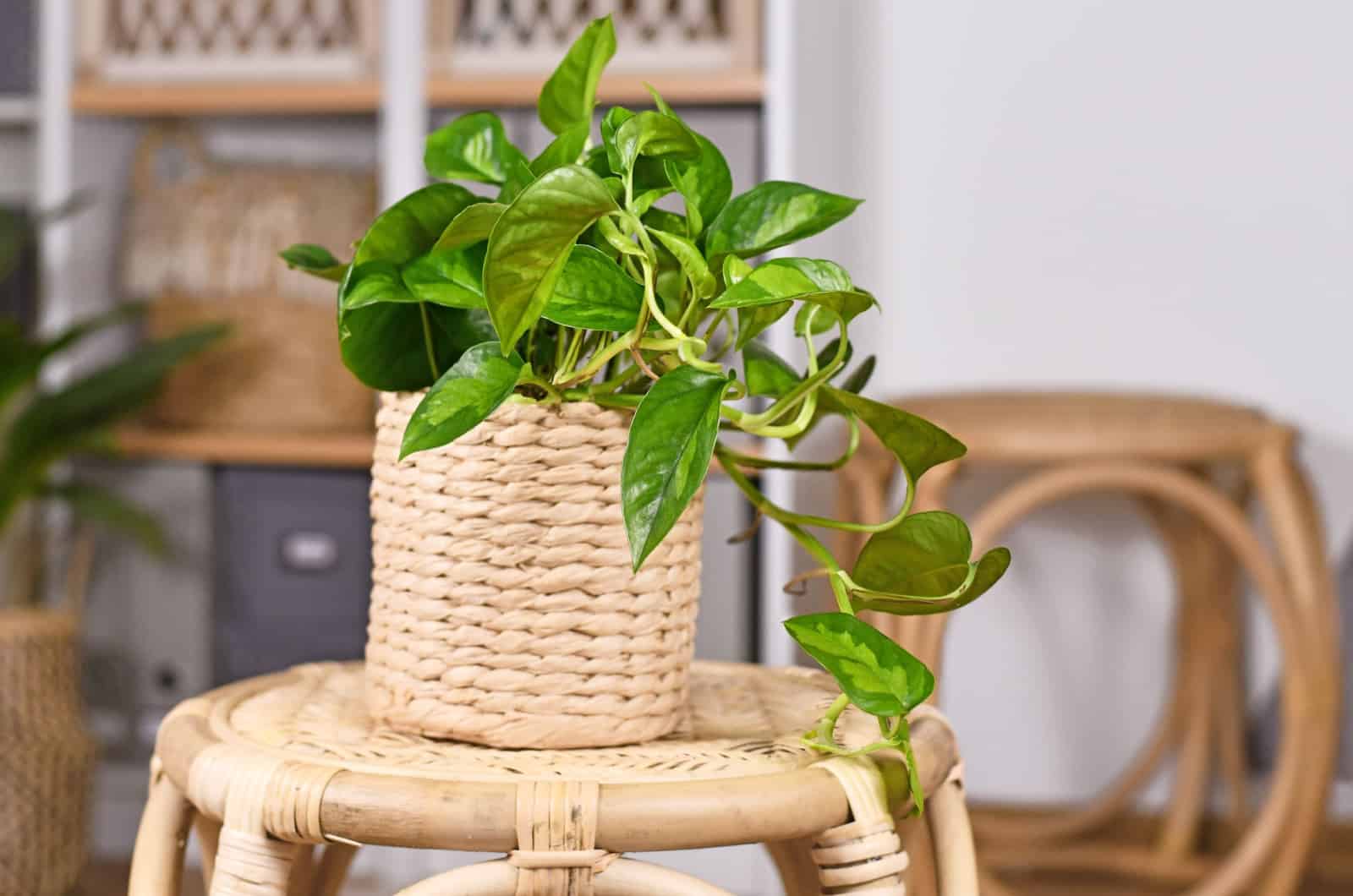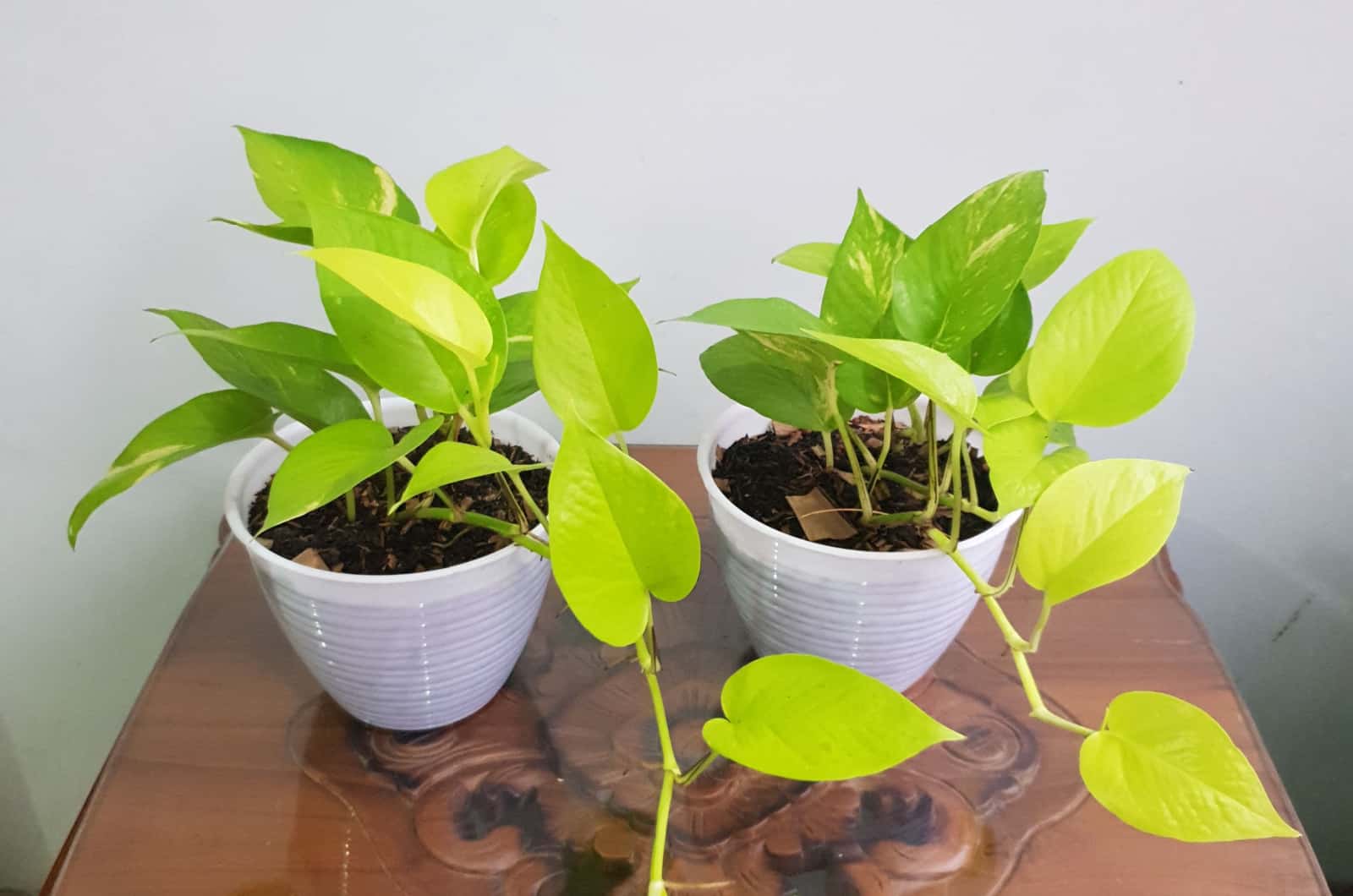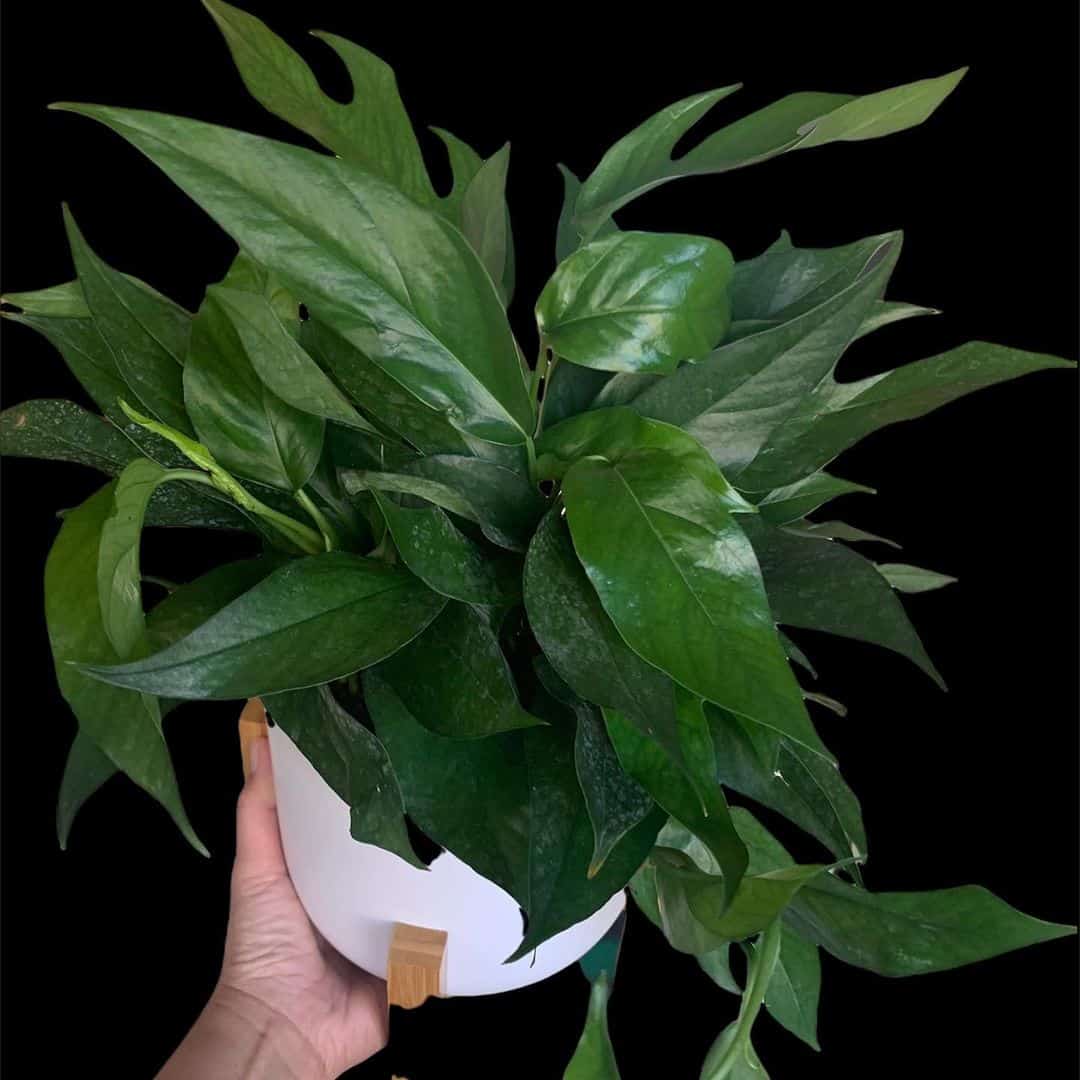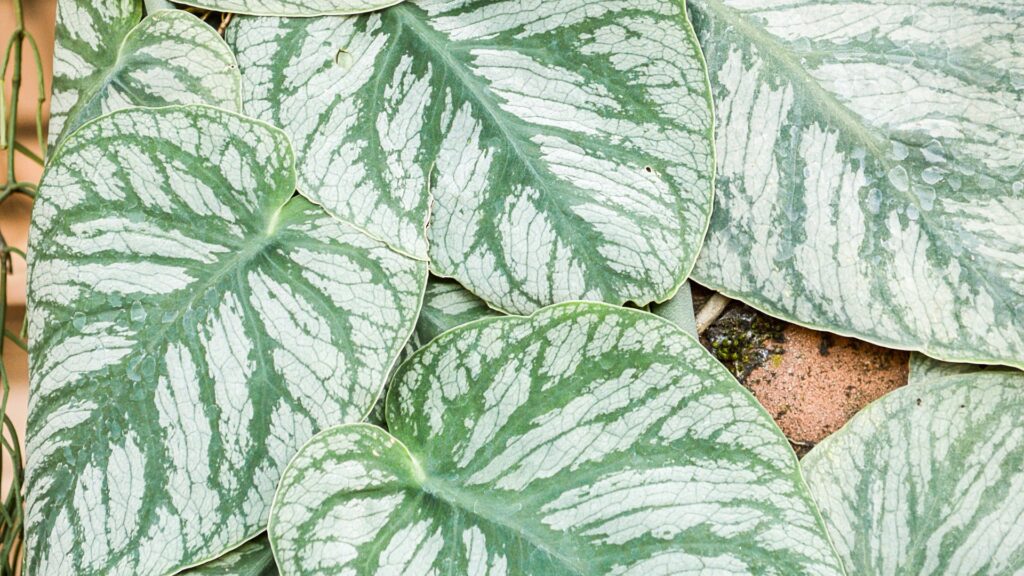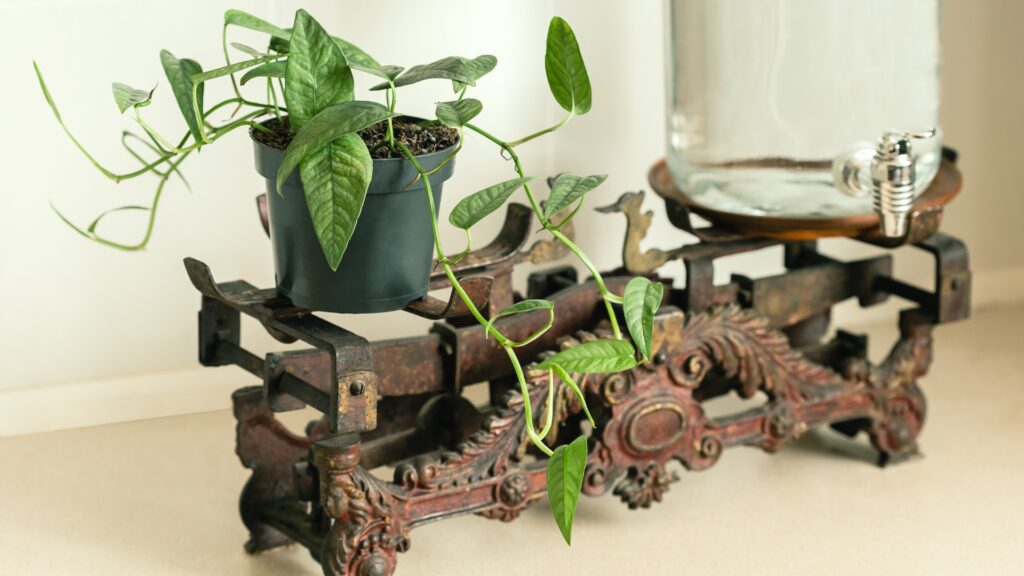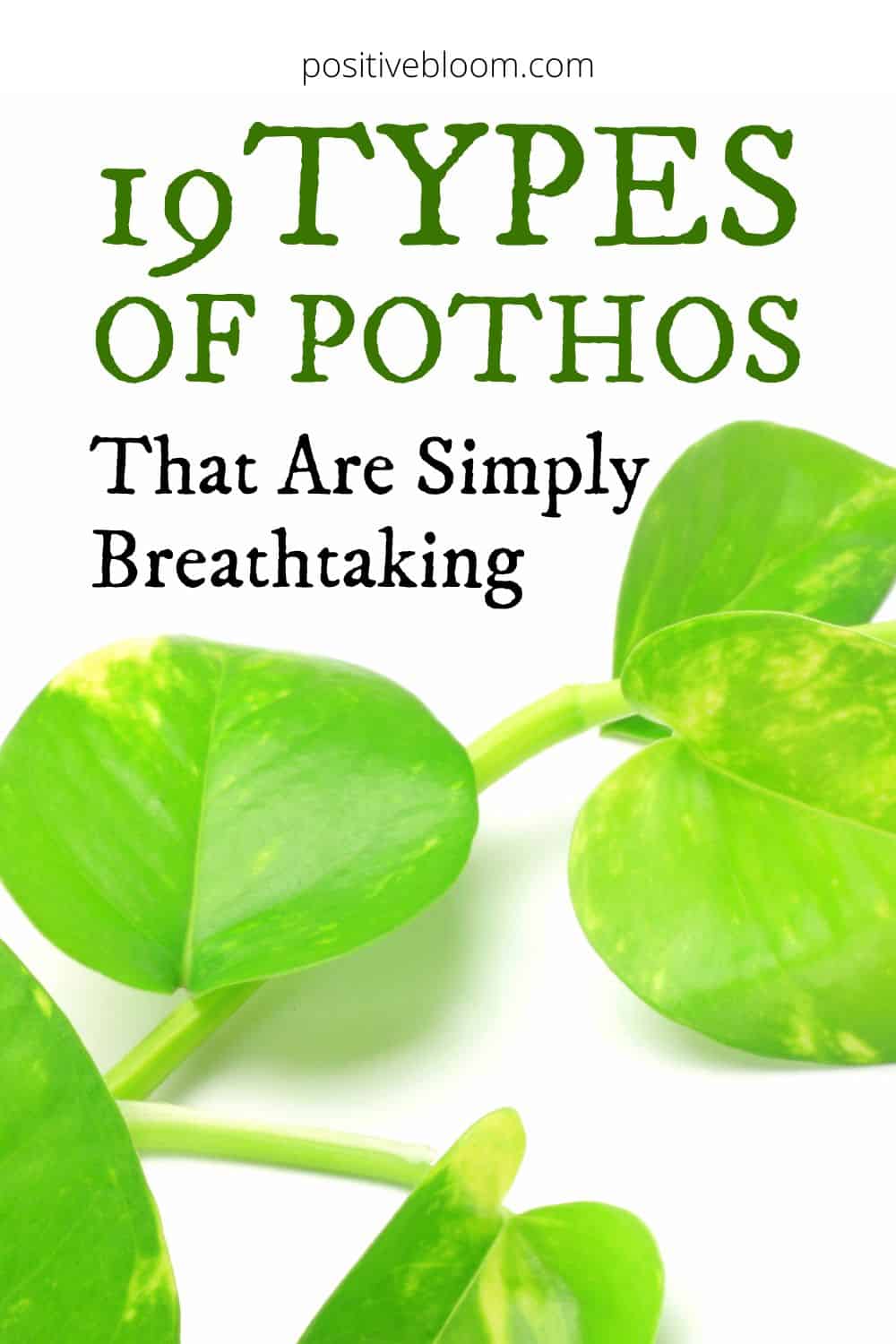Pothos plants have become really popular houseplants recently, mainly because of their beautiful, small leaves and unique, long vines that make them look absolutely gorgeous in planters and hanging baskets.
Not only are they great decorative plants, but they are also quite easy to take care of!
Another interesting thing is that the Golden pothos is considered to be a type of money plant that attracts good fortune and prosperity, which is why it is often used in Feng Shui. Nonetheless, this is just one of many types of pothos plants that are cultivated as indoor plants.
Let’s now take a look at some different pothos varieties to help you find the right one for your home!
Types Of Pothos
Pothos plants, otherwise known as Epipremnum aureum, are tropical plants that originate from tropical regions of Australia, China, Asia, and various islands in the Pacific and Indian Oceans.
They belong to the Araceae family, which contains numerous flowering plants that are usually grown indoors. There are plenty of Pothos cultivars that have different variegations, growth habits, and leaf shapes.
I am sure there’s one out there that suits the home decor of any grower!
Let’s dive in.
1. Neon Pothos
How about growing a neon pothos plant instead of installing neon lights in your room?
Neon pothos is the name given to this species, which grows leaves that are an intense neon green. It is identical to other pothos in terms of plant maintenance and other details, the only distinction is that it is not as trailing as other types.
The neon pothos often gets mistaken for a Lemon Lime philodendron because their leaf variegations are astonishingly similar.
This variety of Pothos enjoys being in medium to bright indirect light, so you better find the right place for it in your home. Trust me, you will love this chartreuse beauty!
2. Jade Pothos
Compared to other Pothos species, the dark green leaves of the Jade Pothos are a little bit smaller. Their size and plant care, however, are identical.
A Jade pothos can be grown in a hanging basket or on a shelf. The forest-green leaves add a lovely splash of color, particularly if your home has minimalistic vibes.
This is a unique pothos variety that can grow in low lights just as well as in bright indirect light.
3. Manjula Pothos
Similarly to the Marble Queen pothos, the Manjula pothos exhibits white and creamy variegation on both sides of its leaves. It is a patent-protected cultivar of Pothos that was developed at the University of Florida.
This is one of the most expensive Pothos plants, but it’s worth every penny for its alluring leaves and trailing vines, which are a beautiful addition to any home, and can give it a cheery vibe!
The Manjula pothos is a rare variety, so you must take good care of it!
Please note that this pothos thrives in bright indirect light, so you shouldn’t put it in low light conditions. However, you should also avoid putting it in direct sunlight as it could possibly lose its leaf variegations and get sunburned.
4. Satin Pothos
The Scindapsus pictus Argyraeus, often known as the Satin pothos, is a species of pothos plant with silver and white variegation all over its leaves. It’s interesting to note that these variations are unique to this particular type as they resemble white specks rather than the lengthy patches that are characteristic of all Pothos species.
As you may have noticed, this pothos is not a part of the Epipremnum genus. However, they are astonishingly similar to pothos plants based on their appearances and plant care requirements. Scindapsus pictus Argyraeus is also a vining plant, just like the majority of pothos’!
Their small leaves can adapt to living in low light conditions, though these plants thrive best in bright indirect light, just like Pothos plants.
5. Silver Satin Pothos
This is another Scindapsus pictus species. It is called Scindapsus pictus Exocita, and has the common name Silver Satin pothos. Unlike the previous variety, the Silver Satin pothos produces large, dark, and thick leaves with silvery splashes all over.
The silvery splashes are not as bright, and they blend in perfectly with the dark green background.
For this plant to thrive, make sure to keep it in indirect bright light. If it is kept in low light it might become leggy. Plant care is the same as for other plants from the Pothos species.
6. Jessenia Pothos
Photo from: @plantsndepression
The Jessenia Pothos has variegations that resemble the Golden pothos, despite having a glossier texture. It was discovered in 2014 by Costa Farms, and was identified as a Marble queen pothos variant.
It produces green leaves with yellowish variegations, but they’re not as prominent as on the Golden pothos.
This trailing Pothos spreads swiftly thanks to its heart-shaped leaves and long vines, so I don’t think you should have any issues with them,
especially if you want to use them to create unique decorations for your home.
Pothos plants will grow well over a trellis, so keep in mind that you may need to prune them so they stay in shape. Though it can tolerate low
light, make sure to keep it in bright indirect light (just like any other Pothos!).
7. Cebu Blue Pothos
Although it is known as the Epipremnum aureum, Epipremnum pinnatum (Dragon’s tail pothos) is the real name of this pothos species. This species is native to the Cebu islands in the Philippines, hence the name Cebu Blue pothos!
Despite its basic green leaves with almost no variegation, you can occasionally see silver glittering areas when it has been grown in the proper conditions. Some gardeners describe their leaf colors as dark blue-green, though my Cebu Blue pothos has pure green foliage.
The Cebu blue Pothos has arrow-shaped leaves, unlike the E. aureum, whereas all the other Pothos we’ve mentioned so far have had either round or heart-shaped leaves.
8. Njoy Pothos
This pothos variation has significantly whiter variegations than other species in its genus.
It often has great trailing properties and is planted for minimalist home décor. Although it can be used as a frame, its vines also make for stunning displays on shelves and in hanging baskets.
This Njoy Pothos is often mistaken for the Pearls and Jade pothos, mainly due to the remarkable resemblance of their variegations.
The Njoy pothos is a slow grower that grows about 6 feet in 3 years. If we take a look at the growth rate of a Golden pothos, which can grow 6 feet in just a few months, we can conclude that the Njoy pothos is a really slow-growing plant.
9. Pearls And Jade Pothos
As we mentioned, this pothos cultivar often gets mistaken for the Njoy pothos, mainly because both are variegated pothos plants that have similar growth habits. However, there is a reason behind these similarities.
Both plants are patented varieties of the Marble queen pothos, which was produced at the University of Florida, so it makes sense that they get mistaken for one another. They are climbing or vining plants that spread widely, which is why they are both members of the genus Epinephr (Devil’s ivy).
Compared to the Marble queen, the foliage of a Pearls and Jade Pothos is thinner and smaller with white-edged light green leaves that have green variegations running through them.
It is also a slower grower, and it thrives in bright indirect light.
10. Marble Queen Pothos
The Epipremnum Aureum ‘Marble queen’ is the most common pothos species that can live happily indoors.
These plants produce dark green leaves that are covered in white and creamy variegations that resemble Marble, which is why they are named Marble queen pothos. The leaf texture is waxy with slightly protuberances on the surface.
The green portion of the leaves contain chlorophyll, which is used for energy and growth. This allows the Marble queen to grow quickly and vigorously compared to other varieties.
Growth habit is what distinguishes the Marble queen and Snow queen pothos from one another, though the Snow queen pothos also has somewhat white variegations compared to the Marble variety.
The Marble Queen Pothos thrives in bright indirect light, and should not be kept in low light conditions. The perfect place for this little queen would be on a bookshelf or in a hanging basket!
11. Golden Pothos
The Golden pothos, often called Devil’s ivy, is a low-maintenance flowering plant with pointed leaves and a unique yellow pattern.
It is frequently cultivated as a hanging plant to add life to a space. The Golden pothos plant is a sign of prosperity and good luck.
As strong sunlight is not good for this plant, it should be kept in indirect light. It requires watering every two weeks so the soil can dry out between waterings, making it the ideal plant for someone who constantly forgets to water their plants.
Read also: How To Revive A Pothos Plant: Causes And Solutions
12. Snow Queen Pothos
Our little queens, both Marble and Snow, look astonishingly alike. Both have variegated leaves and are climbing plants.
However, the Snow queen pothos produces leaves with somewhat bright greens that have white variegations, compared to those of Marbles that have a deep green color with white to yellow variegations.
The amount of variegation is influenced by the light conditions. Give your Snow Queen Pothos more indirect light if you want it to be more variegated.
It’s interesting to note that your Snow queen will grow more quickly if you place it in a low-light environment. This is because the leaves will be less variegated and darker. However, if you keep it in bright indirect light it will grow at a much slower pace.
13. Hawaiian Pothos
Hawaiian pothos is another unique houseplant that is quite easy to cultivate. Compared to the leaves of other pothos, such as the Cebu blue, Hawaiian pothos leaves are incredibly huge and gorgeous.
When the plant is grown inside, the leaves can get as tall as 12 inches long. Dark green, cream, and gold tones are prominently variegated on the heart-shaped leaves.
Although Hawaiian pothos leaves resemble those produced by the Monstera deliciosa, the Hawaiian produces smaller leaves that don’t have fenestrations like those of a Monstera.
In its natural habitat, this pothos climbs onto host plants and has a strong growth rate. When cultivated indoors, it can also grow to be quite huge. If the proper conditions are met, it can reach heights of up to 4 feet and a width of about 2 feet.
This plant is vining, so gardeners frequently support it with a moss pole to foster its growth. If you support the plant with a moss pole or some alternative, you can expect it to grow up to 12 inches in one growing season.
14. Harlequin Pothos
Photo from: @pitterplanter
This is one of the rarest pothos out there!
If you are able to grab one for yourself, consider propagation because this is not a pothos species that you can usually find in a garden center.
What makes this variety so special are its beautiful leaves that are almost completely covered in white variegations. In fact, it looks like they are almost entirely white with just a few deep green variegations around the edges of the leaves.
The leaves can vary, so you never know what type of variegation you will end up with!
Nonetheless, every leaf is unique and gorgeous, and it fits perfectly in minimalist home decor. I wonder if they are named Harlequin after
Harley Quinn, because she has mesmerizing, white hair.
It requires bright indirect light to support growth and development, and they can’t tolerate being in low light environments. A great Harlequin alternative is the Manjula pothos, which is much easier to track down (you can find it on Amazon).
15. Shangri La Pothos
The Pothos Shangri La is a cultivar of the well-known Golden pothos. The pothos Shangri La is known by a variety of names, which it owes to its curly leaves. Common names for it include sleeping pothos and Godzilla pothos.
The distinctive features of this plant are its dark green, closed, and curled leaves. The leaves have pale green and yellow variegations that can offer a unique touch to either a modern or vintage interior decor.
When cultivated in its natural environment, the Shangri La can also develop yellow-green flower spikes, but they don’t typically show up indoors.
This pothos is a vining plant, so one of the first things you’ll notice is that it needs some sort of support for it to completely flourish.
Fortunately, there are great techniques to maintain moisture in a moss pole, which prevents dehydration in your plant.
16. Glacier Pothos
We have already mentioned that the Njoy pothos and Pearl and Jade pothos look astonishingly alike — well, let me introduce you to a third party that is also remarkably similar to these pothos plants, and that is the Glacier Pothos.
Its foliage closely resembles those of the other two, but you can tell them apart because the Glacier pothos produces foliage with somewhat more silvery tones. It also has rounder and smaller leaves compared to the others.
This is also an extremely rare Pothos plant that cannot be found in a regular garden shop. If you get hold of one, make sure that you keep it in a bright indirect light and keep its soil moist.
17. Global Green Pothos
The Global green pothos is a special variety that has completely green leaves with almost no variegations. There are some variations of a light to dark green color, but there are no signs of any other hues and tones.
This green beauty was once considered a rare variety, but it has grown quite popular recently and can be found in many local garden centers and nurseries.
The plant care guide is the same for this pothos, though this variety is more durable when it comes to light conditions. I think that this pothos plant is perfect for all the beginner gardeners out there!
18. Variegated Neon Pothos
Picture the beautiful, light green leaves produced by a Neon pothos, but they are covered in white and yellow speckles all over instead!
There isn’t much difference between a variegated and non-variegated neon pothos in terms of plant care – just the light conditions.
If a variegated pothos grows in low light conditions, it will begin to lose its variegation and look like you have a regular neon pothos instead.
Therefore, you must keep it in bright light to enjoy those beautiful variegations!
19. Baltic Blue Pothos
Photo from: @urban.glamping
The Baltic Blue pothos is similar to the Cebu blue pothos. Both are Epipremnum pinnatum species, and have similar plant care and growth habits.
They also look a lot like each other, though the Baltic Blue pothos produces dark green leaves that have blue undertones. They also have larger and longer leaves that can develop fenestrations (like most Monstera adansonii varieties!).
20. Snow Satin Pothos
If you love the silvery elegance of the Silver Satin pothos but want something with even more contrast, the Snow Satin pothos is a fantastic option. This variety, also known as Scindapsus pictus ‘Silvery Ann,’ features delicate, almost frosty-looking silver variegation that extends further across its leaves compared to other Scindapsus varieties.
The care for Snow Satin is similar to other pothos—it thrives in bright, indirect light but can tolerate lower light conditions. However, more light helps maintain its signature silver markings. With its soft, cascading vines, this variety makes a beautiful addition to any hanging basket or shelf.
21. Skeleton Key Pothos
This is one of the most unique pothos varieties out there! The Skeleton Key pothos starts with traditional heart-shaped leaves, but as the plant matures, the leaves take on a dramatically elongated shape, resembling an old-fashioned key. This transformation makes it a standout among pothos varieties.
Skeleton Key thrives when given a support structure like a moss pole, allowing its leaves to develop their distinct shape.
Brief Pothos Plant Care Guide
If you decide to get one of these types of pothos plants, then check out this brief plant care guide to make sure your plant grows happy and healthy!
Soil Requirements
Pothos plants thrive in well-draining soil that is rich in nutrients. The wrong type of soil might lead to root rot because it holds too much water for the plant. Excess water will be removed with the help of the right soil mixture and drainage holes in the bottom of the pot. You have the option of purchasing or making your own aroid potting soil.
The ideal potting mix can be created by mixing perlite, universal soil mix, and peat moss. Philodendrons can also be grown with this mixture.
Light Requirements
As we have already mentioned several times, pothos plants thrive in bright indirect light.
The leaves of this stunning houseplant are the most important part, so it’s crucial to keep them out of direct sunlight to prevent the variegations from completely fading.
However, because they require sunlight for photosynthesis, keeping them in a low light environment is also not a great idea. The variegation will become green if they don’t receive enough light to make up for the absence of chlorophyll.
Water Requirements
Pothos plants require more frequent watering throughout the summer, which is when they are in their growing season — usually once a week.
However, they only need to be watered every two weeks in the winter.
Wet soil is not good for pothos plants as it might lead to root rot. It is crucial to prevent overwatering at all costs!
The ideal approach when it comes to watering is to wait until the soil is completely dry before watering again. Either stick your thumb in the soil or use a pair of wooden chopsticks to check the soil moisture.
Temperature Requirements
Pothos are tropical plants, so they do best in warm climates.
You should be aware that pothos plants can survive in temperatures between 55 and 85 degrees Fahrenheit, while their preferred conditions are between 70 and 90 degrees.
Any lower or higher temperature would be unhealthy for your pothos.
Humidity Requirements
These tropical beauties are used to growing in humid environments. Though they can tolerate some dry air, humidity levels should not drop below 50%.
The perfect humidity for these plants is around 70%, which is sometimes hard to obtain indoors.
Here are some ways to boost humidity:
• Create a DIY pebble tray to keep your plant moist by simply stacking pebbles in a tray, adding water, and setting your plant on top. The evaporation of the water will provide the moisture your plant needs.
• Spend some money on a humidifier. You can find cheap ones on Amazon that will do the job perfectly!
• Put your plant in a humid room, such as a bathroom or kitchen.
Fertilizer Requirements
Some people believe that fertilizer isn’t necessary for pothos plants. However, a little plant food won’t hurt them!
Fertilize your pothos periodically while it is growing. Then let it rest during the colder months.
Depending on the pothos species, liquid or slow-release fertilizers can be utilized.
Choose a fertilizer that contains nitrogen because it promotes luxuriant leaf growth, which will result in your pothos plant producing a lot more leaves throughout the growing season.
Repotting
Repotting should be done in the spring or early summer at the start of the growing season. Repotting it in winter is not advised because the plant is considerably more delicate and the Pothos’ roots are more susceptible to injury.
Pothos plants need to be replanted every two to three years (their growth pace is also dependent on the conditions provided), and you should always use a larger pot than the one you previously used.
Watering your plant the day before repotting will help to soften the soil and simplify the process.
Fill the bottom half of the new container with a suitable amount of potting soil. After putting the plant in the center, fill the remaining space in the pot with the same soil. If you want, you can also add compost to help the plant settle in.
Propagation
Propagating a Pothos plant is perfect for beginner gardeners that don’t have much experience in this field. These plants can be propagated using two methods: water propagation and root propagation.
Water Propagation
Because you can observe the root growth in the water, this method has become more common than root propagation.
1. Start by looking for a healthy stem with leaves, and cutting it to a length of around 5 inches.
2. Add water to the stem cutting. Use a glass, jar, or vase as appropriate.
3. Keep it in light shade.
4. The establishment of roots will take around a month. When you notice this, bury the cutting in soil.
Root Propagation
When repotting or pruning your plant, you can begin root propagation. It has to be transplanted into a new container using stem cuttings.
1. Select a sturdy stem with at least four leaves and trim it to a length of about 5 inches.
2. Though it’s not required, you can dip the cutting in a rooting hormone.
3. Ensure that the potting soil has already been prepared. Follow the instructions in the plant care manual.
4. Make sure to keep the cutting at its ideal temperature and avoid exposing it to any direct sunlight.
Frequently Asked Questions
1. How many types of pothos are there?
There are 19 known types of pothos plants. However, there could be even more pothos variants, mainly because botanists nowadays are crossing different species and creating new plants.
2. What is the rarest type of pothos?
The rarest type of pothos is definitely the Harlequin. This pothos produces beautiful leaves that are almost entirely covered in white patches, and there are also some green variegations around the edges of the leaves. They fit perfectly into any type of home decor, though I think they look absolutely stunning in minimalistic settings.
3. How do I care for my pothos?
The pothos is a tropical plant that enjoys well-draining and moist soil. You should water it regularly to keep the soil moist, but be careful not to overwater your pothos. Keep it in bright indirect light, and fertilize the plant monthly during the growing season. Make sure that the humidity does not drop below 50%, and keep the temperature around 70 degrees Fahrenheit.
Conclusion
There are many different types of pothos plants, so I am sure that everyone can find one that fits their style. Pothos are common houseplants that are relatively easy to take care of, and they look absolutely stunning either hanging in the baskets or climbing along a trellis.
Make sure that you keep them in bright indirect lights, and keep their soil moist by watering once the topsoil dries out.
If you get a rare pothos species, make sure to propagate it!
I hope this article was helpful.
Until next time!
Like this post? Share or pin it for later!

